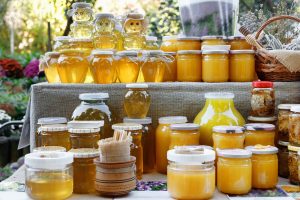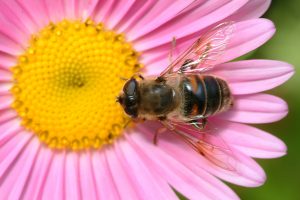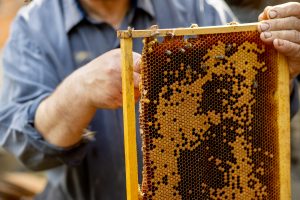Did you know that most honey is typically harvested in late Summer or early Fall? [1] With Summer slowly drawing to an end, this means that harvest time is right around the corner! If you have honey on your list for your next grocery or farmer’s market visit, there are a few things that you should keep in mind.
What is Honey?
Honey is a sweet substance produced by honey bees. While it is widely referred to as a “natural sweetener,” there is actually little difference between how your body recognizes and processes honey vs. standard table sugar. In fact, table sugar, otherwise known as sucrose, is composed of two simple sugars: glucose and fructose. These are also the most abundant sugars in honey! [2] One tablespoon of table sugar yields 49 calories and about 15 grams of carbohydrate. Honey, which is denser than sugar, has 68 calories and 17.2 grams of carbohydrate per tablespoon. However, honey tastes sweeter than sugar so you may use less of it. [3]
As with all other forms of added sugar, it is important to consume honey in moderation. For more information on sugar and recommended intakes, check out our blogs on What’s The Deal With Sugar: Part 1 and Part 2.

What about the bees?
While it is important to know what honey is, it is also just as important to know how honey bees bring it from flower, to hive, to table. Honey bee expert Jennifer Berry from the UGA Honey Bee Program was able to provide insight on nature’s little workers by answering a few questions.
1. How is honey produced? Honey bees collect nectar (sugar water) from flowers. Once back at the hive, bees will deposit the nectar into cells constructed of wax and begin to dehydrate the nectar to produce honey. The bees need to remove most of the water in the nectar to form the honey. Once the water content is below 18%, honey will not spoil or ferment and can last years, decades, even centuries.

2. Why do bees make honey? Honey is their carbohydrate source, whereas pollen is their protein source. Bees store honey because there are periods during the year where nothing is blooming (winter for example). They store honey to survive.
3. Are bees harmed when people take honey from their hive? There are some plants in Georgia that produce nectar that is toxic to bees: Yellow jessamine, Purple titi, and Mountain laurel. But consuming honey (as long as it has not been contaminated with something) as a rule, is not harmful to bees. It is important to leave enough honey for the bees to get through periods when nothing is blooming because if people take too much honey from bees, they will starve.
4. What are some important things to know about honey bees? What are some ways to support bee health and sustainability? Honey bees, along with other bees, pollinate the majority of produce (fruits and vegetables) that humans consume. It is believed that 1 out of 3 bites of food we eat is due to the hard work of honey bees. Here is a list of things that people can do to support bees: plant native flowering trees, shrubs, annuals, and perennials; plant clover yards as opposed to grass; eliminate or reduce pesticide use especially around blooming plants; buy local honey; become a beekeeper; teach family, friends and neighbors about the importance of bees, birds and other pollinators.
To learn more about the UGA Honey Bee Program and it’s efforts throughout the state, please visit our website at www.ent.uga.edu/bees for more information about honey bees and other pollinators.

Written by Darci Bell, RDN, LD and Jennifer Berry, UGA Honey Bee Program| Edited by Laurel Sanville, MS, RDN, LD